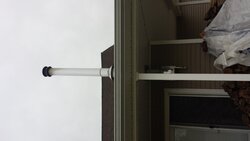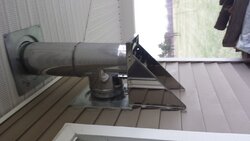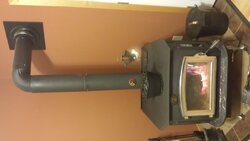Hi All,
Just doing some planning while I'm waiting to turn down the air for the not.



I'm formulating a plan for my first chimney cleaning on my own. We purchased our Buck 81 stove last year and had a certified chimney sweep come out early this fall so that I could watch it done right once before attempting it myself.
Anyways, I've attached three pictures of our setup. The first picture shows our stove which has single wall coming out from the top of the stove in the back, makes a 90 and then heads through the thimble in the wall. We've got a T clean out outside under the porch before the pipe heads straight up through the roof.
The baffle boards are easy to slide out on the Buck, so my plan was to possibly purchase a sooteater and clean from the T through the wall and push everything into the stove (with the door shut), then change gears and use the sooteater and go straight up the rest of the chimney. If it works, it could be a real simple set-up. My concern is whether or not the sooteater can make the bend (slight bend to get into the thimble from the T), run the horizontal, and then make a 90 down to the stove. I'm wondering if that's asking too much.
Option two is to just run a brush up the outside portion of the chimney, remove the single wall inside the house and take it outside for a brushing and then reinstall. It'd be nice to not have to take anything apart, but perhaps that's not feasible.
What do you folks think?
Just doing some planning while I'm waiting to turn down the air for the not.



I'm formulating a plan for my first chimney cleaning on my own. We purchased our Buck 81 stove last year and had a certified chimney sweep come out early this fall so that I could watch it done right once before attempting it myself.
Anyways, I've attached three pictures of our setup. The first picture shows our stove which has single wall coming out from the top of the stove in the back, makes a 90 and then heads through the thimble in the wall. We've got a T clean out outside under the porch before the pipe heads straight up through the roof.
The baffle boards are easy to slide out on the Buck, so my plan was to possibly purchase a sooteater and clean from the T through the wall and push everything into the stove (with the door shut), then change gears and use the sooteater and go straight up the rest of the chimney. If it works, it could be a real simple set-up. My concern is whether or not the sooteater can make the bend (slight bend to get into the thimble from the T), run the horizontal, and then make a 90 down to the stove. I'm wondering if that's asking too much.
Option two is to just run a brush up the outside portion of the chimney, remove the single wall inside the house and take it outside for a brushing and then reinstall. It'd be nice to not have to take anything apart, but perhaps that's not feasible.
What do you folks think?

